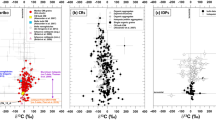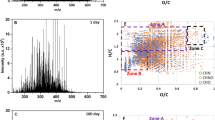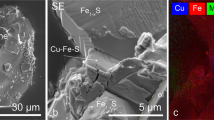Abstract
METEORITES, being solar nebula condensates1, should carry information on the processes which led to formation of the planets. Within this context Green, Radcliffe and Heuer2 studied 1 µm thick foils of the Allende C-3 chondrite by means of high voltage transmission electron microscopy (TEM). Its chondrules (small silicate spheres) showed features which suggested that they were older than the microcrystalline matrix which alone contained carbon. If the matrix crystallized directly from the circumsolar plasma as virgin planetary material3 further study of its carbon phase would be of interest because little is known of the nature of the insoluble carbonaceous “polymers” of meteorites4. The Allende chondrite contains about 0.3% carbon of which 100 p.p.m., extractable by organic solvents, has been extensively studied5. The origin of this organic matter is an extremely controversial subject6.
This is a preview of subscription content, access via your institution
Access options
Subscribe to this journal
Receive 51 print issues and online access
$199.00 per year
only $3.90 per issue
Buy this article
- Purchase on Springer Link
- Instant access to full article PDF
Prices may be subject to local taxes which are calculated during checkout
Similar content being viewed by others
References
Anders, E., Ann. Rev. Astron. Astrophys., 9, 1 (1971).
Green, H. W., Radcliffe, S. V., and Heuer, A. H., Science, 172, 936 (1971).
Arrhenius, G., and Alfven, H., Earth Planetary Sci. Lett., 10, 253 (1971).
Hayes, J. M., Geochim. Cosmochim. Acta, 31, 1395 (1967); Vdovykin, G. P., “Carbonaceous Matter in Meteorites (Organic Compounds, Diamonds, Graphite)” (Nauka Press, Moscow, 1967); NASA Technical Translation TT F-582, 216, Washington, 1970, pp. 216–222.
Simmonds, P. G., Bauman, A. J., Bollin, E. M., Gelpi, E., and Oro, J., Proc. US Nat. Acad. Sci., 64, 1027 (1969).
Studier, M. H., Hayatsu, R., and Anders, E., Geochim. Cosmochim. Acta, 36, 189 (1972).
Johari, Om, Research/Development, 22, 12 (1971).
Irving, S. M., Solid State Tech., 47, June 1971.
Gluskoter, H. J., Fuel, 44, 285 (1965).
Greer, R. T., Proc. Third Ann. Scanning Electron Microscope Sympos., Chicago 1970, 379 (IIT Research Institute, Chicago, 1970).
Greer, R. T., Nature, 224, 1199 (1969).
Zeller, E. J., and Dreschhoff, G., in Millmann, P. M., Meteorite Research (D. Reidel, Dordrecht, Holland, 1969).
Rank, D. M., Townes, C. H., and Welch, W. J., Science, 174, 1083 (1971).
Donn, B., Wickramasingh, N. C., Hudson, J. P., and Stecher, T. P., Astrophys. J. Lett., 157, L 125 (1969).
Eugster, J., Aerospace Med., 36, 834 (1965).
March, H., Dachille, F., Melvin, J., and Walker, P. L., Carbon, 9, 159 (1971).
Robertson, S. D., Carbon, 8, 365 (1970).
Eck, R. V., Lippincott, E. R., Dayhoff, M. O., and Pratt, Y. T., Science, 153, 628 (1966).
Ruff, O., and Bretschneider, O., Z. Anorg. Allgem. Chem., 217, 1 (1934).
Krishnaswami, S., Lal, D., Prabhu, N., and Tamhane, A. S., Science, 174, 287 (1971).
Studier, M. H., Hayatsu, R., and Anders, E., Science, 149, 1455 (1965).
Smale, D., Minerals Sci. Eng., 18 April, 1970.
Allan, G. G., Johnson, P. G., Lai, Y-z., and Sarkanen, K. V., Chemy. Indy., 127, January 23, 1971.
Warf, J. C., and Gutman, V., J. Inorg. Nucl. Chem., 33, 1583 (1971).
Oberlin, M., and Mering, J., Carbon, 1, 471 (1964).
Muenow, D. W., Steck, S. J., and Margrave, J. L., Geochim. Cosmochim. Acta, 35, 1047 (1971).
Hayes, J. M., and Biemann, K., Geochim. Cosmochim. Acta, 32, 239 (1968).
Johnson, B. B., and Cairns, T., Anal. Chem., 44, 24A (1972).
Wachi, F. M., and Gilmartin, D. E., Carbon, 8, 141 (1970).
Hoering, T. C., and Abelson, P. H., Carnegie Inst. Geophys. Lab. Yearbook, 64, 218.
Storch, H. H., Golumbic, N., and Anderson, R. B., The Fischer-Tropsch and Related Syntheses (John Wiley and Sons, New York, 1952).
Carr, M. H., Geochim. Cosmochim. Acta, 34, 689 (1970).
Tamaru, K., American Scientist, 60, 474 (1972).
Author information
Authors and Affiliations
Rights and permissions
About this article
Cite this article
BAUMAN, A., DEVANEY, J. & BOLLIN, E. Allende Meteorite Carbonaceous Phase: Intractable Nature and Scanning Electron Morphology. Nature 241, 264–267 (1973). https://doi.org/10.1038/241264b0
Received:
Revised:
Issue Date:
DOI: https://doi.org/10.1038/241264b0
This article is cited by
-
The role of presolar dust in the formation of the solar system
Earth, Moon, and Planets (1988)
-
Isotopically distinguishable carbon phases in the Allende meteorite
Nature (1982)
Comments
By submitting a comment you agree to abide by our Terms and Community Guidelines. If you find something abusive or that does not comply with our terms or guidelines please flag it as inappropriate.



